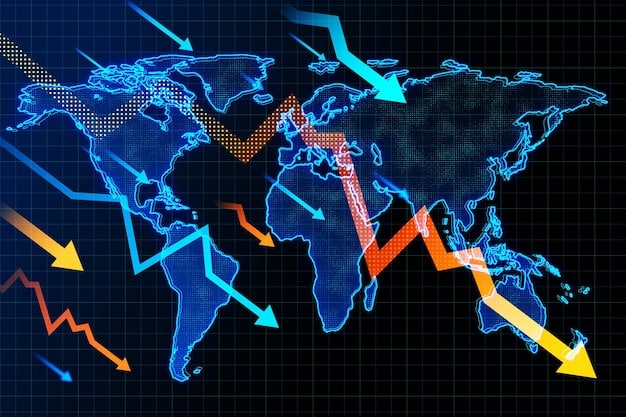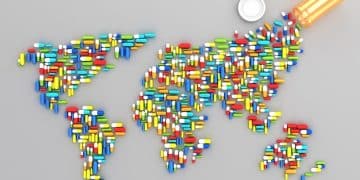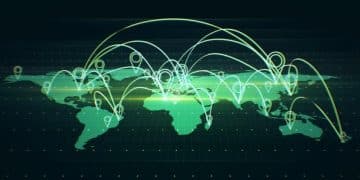Global Inflation Surge: US Economic Stability in 2025 at Stake

The rising global inflation rate poses a significant challenge to US economic stability in 2025 by impacting consumer purchasing power, trade balances, and the Federal Reserve’s monetary policy decisions, potentially leading to slower growth and increased market volatility.
As 2025 approaches, a crucial question looms for policymakers, businesses, and everyday citizens: What the Rising Global Inflation Rate Means for US Economic Stability in 2025. This phenomenon, far from a fleeting concern, represents a complex web of interconnected economic forces that could reshape the American financial landscape, demanding careful analysis and proactive strategies.
The Interconnectedness of Global and US Inflation
The notion that national economies operate in isolation is increasingly outdated in our globalized world. When inflation surges globally, as it has in recent periods, it inevitably casts a long shadow over domestic economies, including that of the United States. This section explores the intricate links between global inflationary pressures and their transmission mechanisms to the US economy.
Understanding this interconnectedness begins with recognizing the role of global supply chains. A significant portion of goods consumed in the US involves international production, sourcing, and transportation. Disruptions or increased costs in any part of this chain, whether due to geopolitical events, natural disasters, or labor shortages, translate directly into higher prices for American consumers and businesses.
Supply Chain Vulnerabilities and Cost-Push Inflation
Global supply chains, optimized for efficiency and cost reduction over decades, proved surprisingly fragile in the face of widespread shocks. The aftermath of the pandemic, coupled with geopolitical tensions, exposed these vulnerabilities. For instance, semiconductor shortages, amplified by demand surges and production bottlenecks in Asia, led to significant price increases in sectors from automotive to electronics in the US.
- Energy Price Volatility: Global energy markets, particularly for oil and natural gas, directly influence transportation costs and manufacturing expenses worldwide. Spikes in these prices, often driven by geopolitical events or OPEP decisions, feed directly into US inflation through higher fuel costs and utility bills.
- Commodity Price Swings: Prices for essential commodities like industrial metals, agricultural products, and raw materials are set globally. When these prices rise internationally, US industries face increased input costs, which are then passed on to consumers.
- Labor Cost Pressures: While more localized, global labor dynamics can indirectly influence US wages. Shortages in key manufacturing hubs or increased labor costs in countries that produce goods for the US market can eventually contribute to higher import prices.
The transmission of global inflation into the US economy through these channels is a form of “cost-push” inflation. Essentially, higher costs for production inputs and transportation abroad translate into higher prices for goods and services sold domestically, regardless of the internal demand dynamics of the US economy. This makes it particularly challenging for domestic policymakers, as the root causes often lie beyond their direct control.
Monetary Policy Responses and Their Global Implications
Central banks worldwide, including the US Federal Reserve, employ monetary policy tools to manage inflation and maintain economic stability. However, when inflation becomes a global phenomenon, the actions of one central bank can have significant ripple effects on others. The synchronized tightening of monetary policies globally, for example, is a double-edged sword, necessary to curb inflation but potentially exacerbating a global slowdown.
The Federal Reserve’s Balancing Act
The Federal Reserve’s primary mandate is to maintain maximum employment and price stability. In an environment of rising global inflation, the Fed faces a delicate balancing act. While domestic factors like a strong labor market or robust consumer demand might suggest tightening, globally driven inflation presents a different challenge. The Fed’s decisions to raise interest rates, for instance, impact not just the US but also global capital flows and exchange rates.
- Exchange Rate Fluctuations: Higher US interest rates can strengthen the dollar, making US exports more expensive but imports cheaper. While this might ease domestic inflationary pressures from imports, it could hurt US exporters and exacerbate trade imbalances. Investors seeking higher returns may also pull capital from emerging markets, destabilizing their economies.
- Capital Flight and Debt Burdens: For countries with dollar-denominated debt, a stronger dollar makes repayments more expensive. This can trigger capital flight from vulnerable economies, pushing their currencies down and making their own inflation worse, creating a feedback loop of instability.
- Global Liquidity: The Fed’s actions significantly influence global liquidity. Tighter US monetary policy can reduce the availability of dollars globally, impacting international trade and investment.
The cumulative effect of these synchronized tightening cycles on the global economy and, by extension, on the US, could be a significant slowdown. While individual central banks are responding to domestic inflationary pressures, the aggregate impact could be a global recession. For the US, this means a potential hit to export demand and increased financial market volatility, even as domestic inflation might show signs of cooling.
Impact on US Consumer Purchasing Power and Demand
Inflation, by its very nature, erodes purchasing power. When prices for goods and services rise faster than wages, consumers can buy less with the same amount of money. Global inflation compounds this effect, as it impacts a wider array of products, including imported staples and goods whose production relies on international supply chains. This erosion of purchasing power directly influences consumer demand, a critical driver of the US economy.

Real Wages and Household Budgets
Even if nominal wages increase, if the rate of inflation outpaces wage growth, real wages decline. This effectively makes households poorer. For many American families, especially those with lower incomes, this means difficult choices about how to allocate their increasingly stretched budgets. Discretionary spending, a key component of economic growth, is often the first casualty.
The ripple effect is profound. Reduced consumer spending translates into lower revenues for businesses, potentially leading to hiring freezes, layoffs, and a slowdown in investment. This dampens overall economic growth prospects for the US in 2025. Furthermore, persistent high inflation can lead to a shift in consumer behavior, with people choosing cheaper alternatives or delaying major purchases, which further perpetuates a cycle of stagnating demand.
Inflationary Expectations and Spending Habits
Beyond immediate financial constraints, sustained inflation can also alter consumer expectations. If individuals anticipate that prices will continue to rise, they might accelerate purchases to beat future price hikes, temporarily boosting demand. However, this can also lead to a “wage-price spiral,” where demands for higher wages to offset inflation lead to businesses raising prices further, perpetuating the inflationary cycle.
Conversely, if consumers become too pessimistic about their future purchasing power, they might save more and spend less, fearing a prolonged period of economic hardship. This contraction in demand would further amplify any global economic slowdown and make it harder for the US economy to achieve robust growth in 2025. The psychological impact of persistent inflation on consumer confidence is a powerful, yet often underestimated, factor in economic stability.
Trade Balances and International Competitiveness
Global inflation significantly alters the landscape of international trade, impacting a nation’s trade balance and the competitiveness of its industries. For the US, a major global player, these shifts can have profound implications for economic stability, affecting everything from export volumes to the allure of foreign investment.
The Dollar’s Strength and Export Challenges
When global inflation prompts other central banks to raise interest rates, or when the US Fed raises rates more aggressively, the dollar can strengthen relative to other currencies. While a strong dollar can make imports cheaper for American consumers (potentially softening imported inflation), it simultaneously makes US exports more expensive for foreign buyers. This can reduce demand for American goods and services abroad, leading to a decline in export volumes. A shrinking export sector can hurt domestic industries, lead to job losses, and exacerbate trade deficits.
Moreover, the cost of production in the US might also rise due to domestic inflationary pressures, further eroding the price competitiveness of American products in global markets. This dual challenge of a stronger dollar and higher internal costs places US exporters at a disadvantage, making it harder to compete with countries where inflation is lower or whose currencies have depreciated more significantly.
Investment Flows and Economic Attractiveness
Periods of global economic instability and high inflation can also influence international investment flows. If the US is perceived as a safer haven or if its interest rates offer more attractive returns compared to other regions, foreign capital might flow into the US. This influx of capital can temporarily strengthen the dollar further and finance a portion of the US current account deficit. However, if global inflation creates widespread uncertainty or dampens global growth, overall foreign direct investment (FDI) might decline, impacting long-term economic development.
Conversely, if other regions manage inflation more effectively, or if their economies offer more promising growth prospects, investment might shift away from the US. The perception of the US as a stable and attractive investment destination is crucial for maintaining economic dynamism and financing innovation. Therefore, the trajectory of global inflation, and the US response to it, will play a significant role in shaping these vital international capital movements in 2025.
Risk of Stagflation and Economic Slowdown
One of the most concerning outcomes of sustained global inflationary pressures is the increased risk of stagflation in the US. Stagflation, a portmanteau of “stagnation” and “inflation,” describes an economic condition characterized by slow economic growth, high unemployment, and rising prices. While the US successfully navigated the stagflationary period of the 1970s, the current confluence of global factors presents a renewed challenge for 2025.
The Confluence of Slow Growth and High Prices
Several global inflationary drivers, such as supply chain disruptions and elevated energy prices, contribute to cost-push inflation, meaning prices rise even without strong demand. Simultaneously, aggressive monetary policy tightening by central banks across the globe, aimed at curbing inflation, can intentionally slow down economic activity. These two forces—cost-push inflation and demand-damping monetary policies—create a perilous environment where the economy could experience both rising prices and reduced output.
- Supply-Side Constraints: Continuing disruptions in global supply chains, coupled with geopolitical events impacting vital resources, limit the economy’s ability to produce goods and services efficiently. This inherent constraint on supply, even with moderate demand, pushes prices higher.
- Monetary Policy Transmission Lag: The effects of monetary tightening are not instantaneous. There is a lag between interest rate hikes and their full impact on inflation and economic activity. This lag means that the economy could still be experiencing slow growth from past policy decisions while new inflationary pressures emerge.
- Consumer and Business Uncertainty: The persistent uncertainty generated by global inflation, geopolitical conflicts, and potential recessions in major trading partners can lead consumers to delay spending and businesses to postpone investment, further contributing to an economic slowdown.
Should the US economy enter a period of stagflation, it would present a formidable challenge for policymakers. The tools used to combat inflation (higher interest rates) can worsen unemployment and slow growth, while measures to stimulate growth (lower interest rates) can exacerbate inflation. This policy dilemma underscores the severity of the risk posed by persistent global inflationary trends.
Geopolitical Factors and Future Economic Shocks
Beyond traditional economic indicators, geopolitical events increasingly act as powerful accelerators or decelerators of global inflation, directly impacting US economic stability. In an interconnected world, regional conflicts, trade disputes, and political instability far from American shores can send significant economic shockwaves across the Atlantic, making a stable forecast for 2025 particularly complex.
Impact of Global Conflicts on Commodities and Trade Routes
The invasion of Ukraine by Russia, for example, sent shockwaves through global energy and food markets, driving up prices worldwide. Russia and Ukraine are major exporters of oil, natural gas, wheat, and other agricultural products. Disruptions to their supply, whether intentional or as a consequence of conflict, directly contribute to inflationary pressures. Similarly, tensions in critical shipping lanes, like the Red Sea, can increase transit times and insurance costs, factors that inevitably translate into higher prices for goods reaching US shores.
- Energy Supply Shocks: Geopolitical instability in oil-producing regions or major energy transit routes can trigger sudden and sharp increases in crude oil and natural gas prices. Given the global reliance on these commodities, such shocks rapidly fuel inflation across virtually all sectors.
- Food Security Concerns: Conflicts or climate-related events in major agricultural regions can disrupt global food supplies, leading to higher food prices. This particularly affects lower-income households and can contribute to social instability in various parts of the world, with potential ripple effects on migration and aid budgets.
- Strategic Resource Control: Competition for strategic minerals and rare earth elements, vital for modern technology and green energy, is intensifying. Geopolitical maneuvering around these resources can lead to supply restrictions and price spikes, affecting manufacturing costs globally.
The unpredictability of these events means that the US economy must build greater resilience into its supply chains and diversify its sources of critical imports. Relying too heavily on a single region or pathway for essential goods exposes the US economy to exogenous shocks that can quickly derail domestic stability. Proactive diplomatic engagement, strategic alliances, and investment in domestic production capabilities are crucial buffers against these externally generated inflationary pressures.
Policy Responses and Outlook for US Stability in 2025
Navigating the turbulent waters of rising global inflation will require a multi-faceted and adaptive policy approach from the US in 2025. There’s no silver bullet, but a combination of monetary, fiscal, and structural reforms can help temper the impact of external price pressures and safeguard domestic economic stability.
Monetary Policy: The Fed’s Evolving Strategy
The Federal Reserve will likely continue to monitor both domestic and global inflationary trends closely. While its primary tools remain interest rate adjustments and quantitative tightening, the global context demands a nuanced approach. The Fed must consider the impact of its policies on the dollar’s value and global capital flows, aware that overly aggressive tightening could trigger a global recession that circles back to harm the US.
Expect the Fed to prioritize data-driven decisions, remaining flexible and communicating its intentions clearly to manage market expectations. The challenge will be to bring inflation back to its target without causing undue economic pain or triggering widespread financial instability.
Fiscal Policy and Targeted Interventions
On the fiscal side, the US government can play a supportive role. While broad-based stimulus measures might exacerbate inflation, targeted fiscal policies can address specific areas of vulnerability. This might include investments to strengthen domestic supply chains, subsidies for green energy to reduce reliance on volatile fossil fuels, or temporary relief programs for vulnerable households impacted by high prices.
Additionally, fiscal discipline will be crucial. Reducing budget deficits, where appropriate, can help temper aggregate demand and signal fiscal responsibility, complementing the Fed’s efforts to control inflation without adding excessive new money into the economy.
Structural Reforms for Long-Term Resilience
Perhaps the most critical, albeit long-term, responses lie in structural reforms aimed at building economic resilience. These include investments in infrastructure to improve logistics and reduce transportation costs, funding for education and workforce development to address labor shortages, and fostering competition across sectors to prevent price gouging and enhance efficiency.
Diversifying trade relationships and reducing over-reliance on single points of failure in global supply chains are also vital. Encouraging “friend-shoring” or “near-shoring” for critical goods can shorten supply lines and reduce exposure to geopolitical risks. These foundational changes are essential for ensuring that the US economy can absorb future global shocks without compromising stability.
| Key Aspect | Brief Description |
|---|---|
| 📈 Global Supply Chains | Disruptions abroad lead to higher import costs, fueling US inflation. |
| 🏦 Monetary Policy Divergence | Fed rate actions can impact capital flows, dollar strength, and global liquidity. |
| 📉 Consumer Purchasing Power | Rising prices erode real wages, potentially slowing overall consumer demand. |
| ⚔️ Geopolitical Volatility | Conflicts and trade disputes drive commodity prices up and disrupt trade routes. |
Frequently Asked Questions About Global Inflation and US Stability
Global inflation drives up the cost of raw materials, labor, and transportation internationally. When US companies import goods or components from other countries, these higher costs are passed on, directly increasing the prices of imported products sold in the US. Even if the dollar strengthens, global manufacturing costs can still lead to higher import prices.
Yes, a stronger US dollar can make imported goods cheaper when purchased in dollar terms, potentially offsetting some of the global inflationary pressures. However, this effect isn’t universal; it depends on the severity of global price increases, the elasticity of demand, and whether foreign suppliers choose to absorb some of the exchange rate difference rather than pass it on fully to consumers.
A “wage-price spiral” occurs when rising prices lead workers to demand higher wages, which in turn prompts businesses to raise prices further to cover increased labor costs, creating a continuous loop. While the US labor market currently shows some wage growth, the risk of a full-blown spiral in 2025 depends on the persistence of high inflation and the ongoing balance of power between labor and employers.
Geopolitical events, such as wars, trade disputes, or political instability, can disrupt crucial supply chains, impose sanctions, or restrict the flow of key commodities like oil, natural gas, or food. These disruptions reduce supply relative to demand, driving up global prices for these essential goods and their derivatives, consequently feeding into broader inflationary trends.
Coordinated efforts among central banks can amplify the impact of monetary policy. If multiple central banks simultaneously tighten policy aggressively, it can collectively slow global demand and liquidity, which can be more effective in combating widespread inflation than individual actions. However, such coordination also carries the risk of a synchronized global economic slowdown or recession if overdone.

Conclusion: Navigating a Complex Economic Future
The rising global inflation rate presents a multifaceted challenge to US economic stability in 2025, one that extends far beyond domestic monetary policy. From the intricate vulnerabilities of global supply chains and the ripple effects of geopolitical conflicts to the erosion of consumer purchasing power and shifts in international trade dynamics, the interconnectedness of the modern global economy means that the US cannot insulate itself from external price pressures. Policymakers face a delicate balancing act, requiring not just astute monetary management from the Federal Reserve but also strategic fiscal interventions and meaningful structural reforms to build long-term resilience. The outlook for 2025, while complex, hints at a period demanding adaptability, vigilance, and perhaps a re-evaluation of long-held economic paradigms to effectively safeguard American prosperity amidst global economic turbulence.





